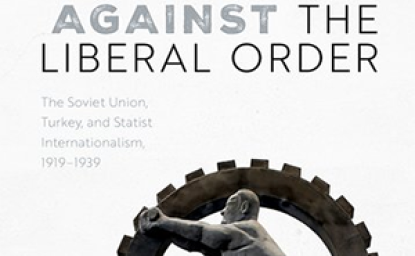Soviet Soft Power and the Polish Thaw, 1943-57

Historians have paid little attention to how Soviet cultural and propaganda institutions attempted to sway public opinion in post-World War II east European societies. In the process, according to Patryk Babiracki, Assistant Professor of History, University of Texas-Arlington, and Title VIII-Supported Research Scholar, Kennan Institute, the Soviets squandered considerable human potential on their side, which could have promoted more effective soft power initiatives.
Babiracki explained that Stalin’s death in 1953 led to several changes in how the Soviet leadership governed both domestically and internationally. For example, the Soviet security police’s power was reduced, discrediting earlier methods of rule. In Poland’s case, the recall of the notoriously heavy-handed Soviet ambassador, Georgii Popov, in March of 1954 constituted one of the most obvious signs of improvement in Soviet-Polish relations. The era of “collective leadership,” in addition to Khrushchev’s ascendance to power, offered new possibilities for reciprocal cultural relations and more flexible Soviet approach.
Other aspects of the “Thaw” in the USSR and Poland, however, further complicated the work of Soviet international outreach institutions, revealing the limitations of Soviet soft power and of the Kremlin’s capacity to maintain empire via non-coercive means. The new Soviet “hands off” approach to East European affairs, according to Babiracki, meant that a number of institutions that hitherto intervened in the cultural affairs of the Soviet Union’s East European satellites were suddenly deprived of Moscow’s support. This was the case, Babiracki continued, despite the fact that many Soviet officials working for these organizations actually had good ideas about how to run them more effectively. For instance, the Soviet Information Bureau, which had been pressuring East European newspaper editors to publish Soviet articles, faced budget and staffing cuts. Freedom, the Soviet army’s newspaper for the Polish population, was shut down at the end of 1954.
Those resourceful Soviet officials and cultural figures who remained in charge of cultural outreach had many reasons to be frustrated as well, Babiracki asserted. First, while the “thaw” began in the Soviet Union, by early 1955 the liberalizing trends in Poland outpaced those taking place in the USSR. The speaker cited Adam Ważyk’s “Poem for Adults,” published in the summer of 1955 in the Polish United Workers’ Party’s journal Nowa Kultura, as a prime example of such trends. The poet described the members of Poland’s working class not as symbols of socialist morality and active builders and beneficiaries of socialism, but as a primitive, wanton mob “howling from boredom.” While sections of cultural—and even political—elites defended such radical critiques of what seemed to be a bygone era, even generally sympathetic Soviet observers found them hard to digest.
Soviet officials in charge of cultural contacts with Eastern Europe were equally concerned about their persistent inability to deliver Soviet propaganda and cultural products of high quality and in sufficient quantities. Despite Soviet oversight, Poles and other East European societies generally held on to higher pre-war standards in areas such as literature or the arts. But a new wave of cultural interventions from Western nations including Great Britain, France and United States, raised the standards to a level with which the Soviets could not compete. Additionally, the general opening of Eastern European countries to more vigorous cultural cooperation with one another and with the world discouraged Soviet cultural initiatives. By 1954-55, the official “Socialist” culture in Eastern Europe also bore fruit in the form of folk dance and song ensembles whose performances matched in quality the performances of their Soviet analogues. Commenting on these developments in January of 1955, Soviet ambassador to Poland Mikhailov remarked in his report to Moscow that “in the artistic affairs we must not only teach the Polish comrades, but also sometimes learn from them as well.” “Such an official statement would have been impossible only two years before,” Babiracki emphasized.
The growth of Soviet-East European mass contacts via student exchanges further undermined Soviet efforts to project its image in the socialist “near abroad.” Both exchanges and tourism eliminated much of the distance between the Soviet Union and socialist countries that had characterized the pre-war years. As a result, they exposed the hyperbolic claims of each socialist country’s rosy propaganda about life in the other countries, particularly the Soviet Union.
In the postwar decade, Babiracki concluded, Soviet soft power in Poland and other East European countries remained a “moving and elusive target.” The underlying structural flaws of the Soviet system—and not necessarily the lack of will or good ideas about how to improve the efficacy of cultural outreach initiatives—help to explain a major Soviet weakness in the early Cold War.
William Pomeranz, Acting Director, Kennan Institute
Author

Kennan Institute
After more than 50 years as a vital part of the Wilson Center legacy, the Kennan Institute has become an independent think tank. You can find the current website for the Kennan Institute at kennaninstitute.org. Please look for future announcements about partnership activities between the Wilson Center and the Kennan Institute at Wilson Center Press Room. The Kennan Institute is the premier US center for advanced research on Eurasia and the oldest and largest regional program at the Woodrow Wilson International Center for Scholars. The Kennan Institute is committed to improving American understanding of Russia, Ukraine, Central Asia, the South Caucasus, and the surrounding region through research and exchange. Read more



